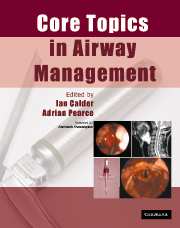Book contents
- Frontmatter
- Contents
- List of contributors
- Preface
- Acknowledgements
- List of abbreviations
- 1 Anatomy
- 2 Physiology of apnoea and hypoxia
- 3 Physics and physiology
- 4 Cleaning and disinfection of airway equipment
- 5 General principles
- 6 Maintenance of the airway during anaesthesia: supra-glottic devices
- 7 Tracheal tubes
- 8 Tracheal intubation of the adult patient
- 9 Confirmation of tracheal intubation
- 10 Extubation
- 11 Light-guided intubation: the trachlight
- 12 Fibreoptic intubation
- 13 Retrograde intubation
- 14 Endobronchial and double-lumen tubes, bronchial blockers
- 15 ‘Difficult airways’: causation and prediction
- 16 The paediatric airway
- 17 Obstructive sleep apnoea and anaesthesia
- 18 The airway in cervical trauma
- 19 The airway in cervical spine disease and surgery
- 20 The aspiration problem
- 21 The lost airway
- 22 Trauma to the airway
- 23 Airway mortality associated with anaesthesia and medico-legal aspects
- 24 ENT and maxillofacial surgery
- 25 Airway management in the ICU
- 26 The airway in obstetrics
- Index
4 - Cleaning and disinfection of airway equipment
Published online by Cambridge University Press: 15 December 2009
- Frontmatter
- Contents
- List of contributors
- Preface
- Acknowledgements
- List of abbreviations
- 1 Anatomy
- 2 Physiology of apnoea and hypoxia
- 3 Physics and physiology
- 4 Cleaning and disinfection of airway equipment
- 5 General principles
- 6 Maintenance of the airway during anaesthesia: supra-glottic devices
- 7 Tracheal tubes
- 8 Tracheal intubation of the adult patient
- 9 Confirmation of tracheal intubation
- 10 Extubation
- 11 Light-guided intubation: the trachlight
- 12 Fibreoptic intubation
- 13 Retrograde intubation
- 14 Endobronchial and double-lumen tubes, bronchial blockers
- 15 ‘Difficult airways’: causation and prediction
- 16 The paediatric airway
- 17 Obstructive sleep apnoea and anaesthesia
- 18 The airway in cervical trauma
- 19 The airway in cervical spine disease and surgery
- 20 The aspiration problem
- 21 The lost airway
- 22 Trauma to the airway
- 23 Airway mortality associated with anaesthesia and medico-legal aspects
- 24 ENT and maxillofacial surgery
- 25 Airway management in the ICU
- 26 The airway in obstetrics
- Index
Summary
Decontamination is the combination of processes, including cleaning, disinfection and/or sterilization, used to render a reusable medical device safe for further use. It is important because of the risk of transmission of hospital acquired infections and transmissible spongiform encephalopathies. The recommendations of the Department of Health are clear and detail that single use disposable airway equipment should be used where possible. Where this is not possible, equipment should be sterilized by heat (autoclave) and where this is not possible cold, chemical sterilization or disinfection by an automated process should be used. The term disinfection means the elimination of all vegetative pathogenic organisms such as bacteria and viruses, and sterilization indicates the elimination of all pathogens including spores. For a terminally sterilized medical device to be labelled sterile, the theoretical probability of there being a viable microorganism present on the device should be equal to or less than 1 × 10–6.
An additional infective agent, the abnormal prion protein PrPSc, has great public health implications as it is the probable mechanism of transmission of variant Creutzfeldt–Jakob disease (vCJD). This prion protein cannot be eliminated by chemical means or temperatures reached in the standard autoclave. Temperatures approaching those required for incineration are needed. Reusable equipment should never be used in patients known or suspected of having vCJD unless the equipment is to be destroyed after use. In the case of flexible fibrescopes, dedicated endoscopes may be obtained from the National CJD Surveillance Unit in Edinburgh. All trusts should have Infection Control Committees and Teams which are responsible for preparing infection control policies to conform to all national and international standards and recommendations.
Single use, disposable
Single use equipment eliminates the risk of cross infection between patients through the airway device.
- Type
- Chapter
- Information
- Core Topics in Airway Management , pp. 31 - 34Publisher: Cambridge University PressPrint publication year: 2005



